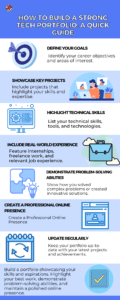How to Build a Strong Tech Portfolio: A Quick Guide
A strong tech portfolio helps you stand out in the competitive tech industry. Whether you are a recent graduate or an experienced professional, a well-crafted portfolio can help you land your dream job. Let’s explore how to build a compelling tech portfolio.

1. Start with a Clear Purpose
First, define the purpose of your portfolio. Ask yourself what you want to achieve. For example, are you seeking a new job, freelance work, or aiming to showcase a specific skill? Your purpose will guide your portfolio’s content and design.
Consider:
- Your target audience: Employers, clients, or collaborators.
- Your career goals: What do you want to accomplish?
2. Showcase Your Best Work
Next, highlight your best projects. Choose examples that clearly show your skills and achievements. Include a variety of projects to demonstrate your versatility. For instance, showcase web development projects, app designs, or data analysis work.
Include:
- Project descriptions: Explain each project’s purpose and your role.
- Technologies used: List the tools and technologies you employed.
- Results and impact: Highlight the outcomes and benefits.
3. Create a Professional and User-Friendly Design
Then, focus on your portfolio’s design. Ensure it is professional and easy to navigate. A clean layout helps visitors find what they need quickly. Therefore, use clear headings, sections, and a consistent style.
Design tips:
- Use a simple color scheme: Stick to a few colors.
- Optimize for mobile: Ensure it looks good on all devices.
- Include a search feature: Help users find specific projects or skills.
4. Include Detailed Case Studies
Additionally, add detailed case studies. Case studies offer deeper insights into your work. Describe the problem, your process, and the results. This provides a comprehensive view of your capabilities.
Structure case studies like this:

- Problem: What challenge did you face?
- Solution: How did you address it?
- Results: What was the outcome?
5. Add Testimonials and References
Moreover, include testimonials. Add feedback from previous employers, clients, or colleagues. Positive testimonials boost your credibility and highlight your skills in a real-world context.
Sources for testimonials:
- Previous employers or managers: Request feedback on your work.
- Clients: Ask for a testimonial if you did freelance work.
- Colleagues: Include references from team projects.
6. Highlight Relevant Skills and Certifications
Also, list your relevant skills and certifications. This helps potential employers or clients quickly see your qualifications. Include both technical and soft skills.
List:
- Technical skills: Programming languages, tools, and technologies.
- Certifications: Relevant certifications you hold.
- Soft skills: Communication, teamwork, and problem-solving abilities.
7. Keep Your Portfolio Updated
Regularly, update your portfolio. Keep it current with new projects, skills, and achievements. Regular updates show your active engagement and commitment to growth.
Update tips:

- Add new projects: Regularly showcase your latest work.
- Update skills and certifications: Reflect new qualifications.
- Review and refine: Check for outdated or irrelevant content.
8. Make It Easy to Contact You
Finally, make it easy for visitors to contact you. Include clear contact information. Offer multiple ways to reach you, such as email, social media links, and a contact form.
Provide contact options:
- Email address: Ensure it’s professional.
- Social media links: Include LinkedIn or other relevant profiles.
- Contact form: Allow visitors to send a message directly.
Final Thoughts
Building a strong tech portfolio takes effort and attention to detail. Showcase your best work, design a professional layout, and include detailed case studies. Keep it updated and make it easy to contact you. With a well-crafted portfolio, you’ll be set for success in the tech industry!

